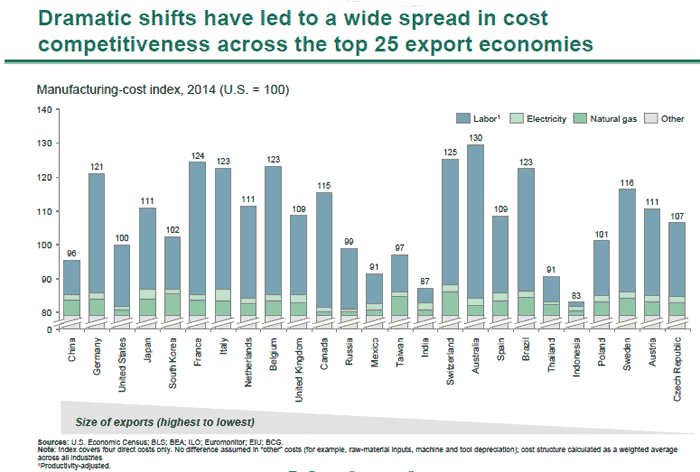From SCDigest's On-Target E-Magazine
- June 25, 2014 -
Supply Chain News: Global Manufacturing Cost Competitiveness by Country Continues to Change, New Boston Consulting Group Study Finds
China, Brazil "Under Pressure" Report Says, While US and Mexico Claimed as Rising Stars
SCDigest Editorial Staff
Boston Consulting Group (BCG) recently continued with series of excellent reports on US and global manufacturing issues, most recently analyzing changes to relative manufacturing costs across the top 25 exporting countries.
SCDigest Says: |
 |
Will all this result in the numbers truly showing a return of manufacturing to US soil? |
|
What Do You Say?
|
|
|
|
The bottom line: a series of factors have led to "dramatic changes" in relative cost structures across the group, and the US and Mexico are cited as "rising stars" in terms of competitiveness. On the other hand, Russia, China and especially Brazil are seeing their competitiveness slip.
The BCG analysis looked at the largest 25 global exporters, which cover more than 90% of total world exports. It has created an index to measure relative cost competitiveness based on what is says are the four direct drivers of manufacturing costs: wages, productivity growth, energy costs, and exchange rates. It therefore does not cover other items that also affect total costs in a given country, such as tax structures, regulatory burdens, logistics costs, and more. Still, it seems to SCDigest a reasonable framework nevertheless.
The US is used as the baseline score, by definition therefore given an index score of 100. From that, the scores ranges from a low of 83 for Indonesia (meaning costs there on average are 17% lower than in the US) to a high of 130 for Australia (30% higher than US costs).
In total, 7 countries have scores lower than 100 (including China at 96), while the remaining 17 countries have higher index values than does the US, as shown in the chart below.
But of course, this index is only looking at direct manufacturing costs - it is not considering the other items listed above, as well as intellectual property risk, longer lead times, higher inventory levels, international shipping costs, etc. So, even at four percent below US manufacturing costs, China's score of 96 would seem to make it relatively unattractive on a cost basis alone for goods consumed in the Americas.

Source: Boston Consulting Group
But perhaps as important as the current scores are the trends - China's score for 2004, for example, was just 86, meaning it was 14% less expensive than the US, losing about 10 percentage points of advantage over the last decade.
(Manufacturing Article Continued Below)
|